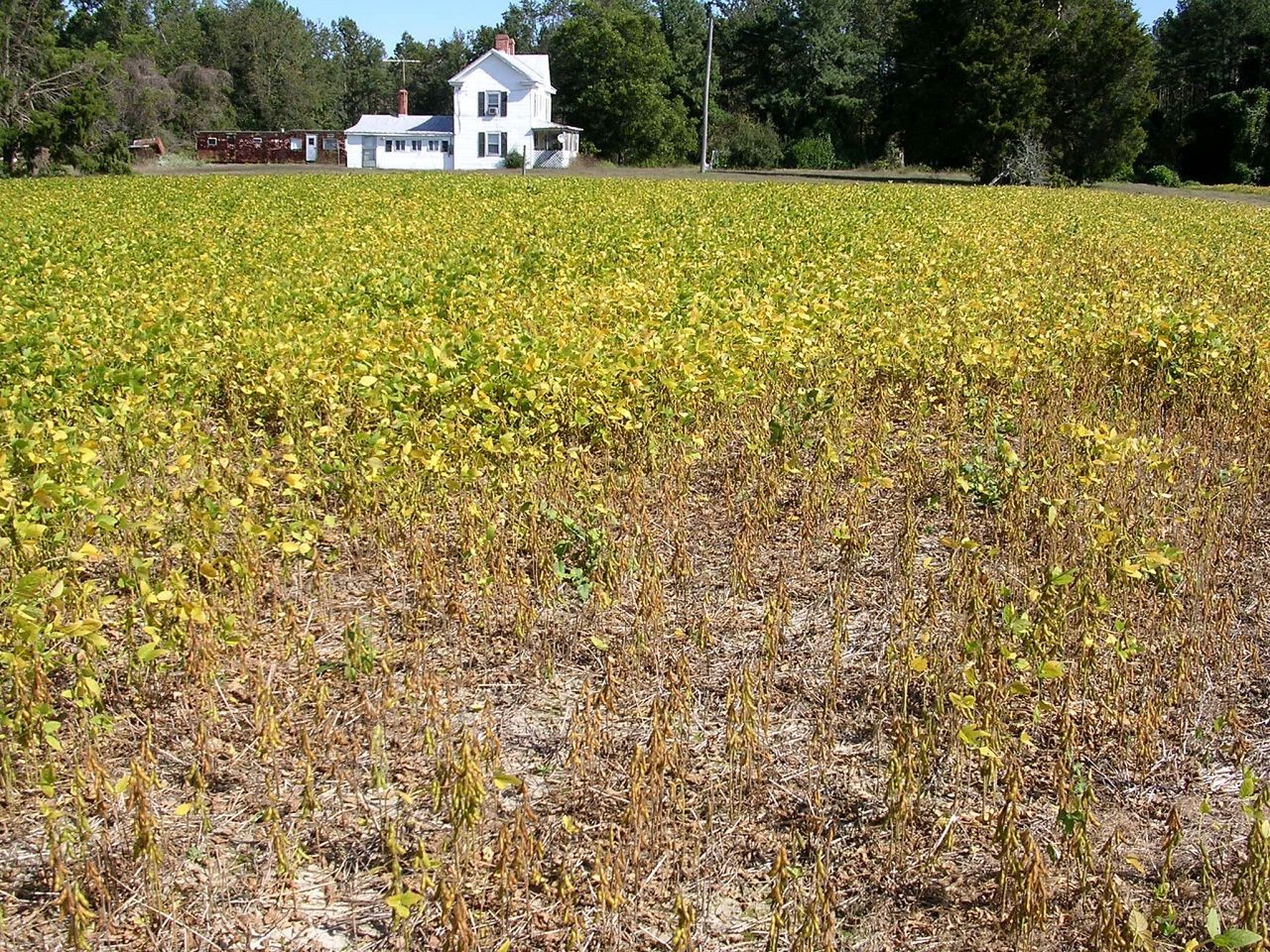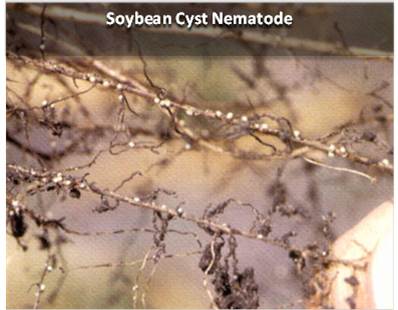Nematodes are unsegmented roundworms, some of which feed in or on roots of plants. More than 100 species of plant-parasitic nematodes feed on soybean roots, but only a few are economically important. In Virginia, most nematode species are found in the sandier Coastal Plain soils. However, some nematode species can also develop and reproduce on the heavier-textured soils of the Piedmont and Shenandoah Valley. This guide will focus on those that can cause damage to soybean in Virginia.
Many soybean growers do not realize that nematodes may be reducing yields by 7-8%. Therefore management of these pests begins with sampling and determination of the species and number present. If nematodes are determined to be a threat, certain management practices are available to help prevent further spread and reduce the economic losses that they cause.
During 2007-2010, over 1000 soil samples were taken and analyzed for nematodes in problematic corn and soybean fields in eastern Virginia. These fields were not chosen at random, but were selected because of low productivity or were showing symptoms that were typical of nematode damage. Of the “problem” soybean fields, 98% contained nematodes and 71% of the fields were at moderate to high risk of nematodes causing a significant yield loss.

 Sampling and Thresholds. Virginia Tech’s Nematode Advisory Program depends on the cooperation of the agricultural community, Extension Agents, and the Nematode Assay Laboratory. Proper sampling, completion of appropriate forms, and careful laboratory analysis are all necessary to provide the grower with appropriate recommendations on nematode management. The Nematode Advisory Program can help growers avoid costly yield loss due to plant-parasitic nematodes if the steps outlined below are followed.
Sampling and Thresholds. Virginia Tech’s Nematode Advisory Program depends on the cooperation of the agricultural community, Extension Agents, and the Nematode Assay Laboratory. Proper sampling, completion of appropriate forms, and careful laboratory analysis are all necessary to provide the grower with appropriate recommendations on nematode management. The Nematode Advisory Program can help growers avoid costly yield loss due to plant-parasitic nematodes if the steps outlined below are followed.
The Virginia Tech Nematode Assay Laboratory currently performs assays for two different purposes:
- Predictive: The predictive assay determines if nematode populations at harvest are likely to affect next year’s crop. There is a fee for predictive samples. Routine assays are $11 per sample and routine plus cysts are $19 per sample.
- Diagnostic: The diagnostic assay determines if poor growth in the current year’s crop is caused by nematodes. There is no fee for diagnostic samples.
When to Sample. The most appropriate time to sample depends on the crop and the purpose of the sample.
Predictive Assays: Fall sampling provides the most reliable information for predicting nematode problems for a future crop. Nematode populations are highest at the end of the growing season and decline as the soil temperatures drop. Sample at or immediately after harvest of previous crop, September 15 to November 15.
Diagnostic Assays: Sample at the onset of symptoms, during the growing season. Nematodes feed only on living plants; therefore, sample soil around live plants showing symptoms. Some nematodes spend part of their life cycle inside the roots and more accurate diagnosis of nematode damage can be made from samples including roots. Also, send another sample from a healthy plant to compare population densities.
How to Sample. Always sample within the feeder-root zone; this varies for each crop. Avoid collecting samples when the soil is extremely dry or extremely wet. DO NOT add water to the soil after sampling. Sample areas of common crop history. For example, if one half of the field is planted to corn and the other half to soybean, sample each area separately.
- Collect vertical core subsamples of soil with a soil sampling core or shovel within the feeder-root zone (see figure at right).
 A 6″ depth should be adequate. Nematodes do not occur uniformly throughout a field; thus, more than one subsample must be taken from the same field. The number of subsamples needed depends on the size of the field:
A 6″ depth should be adequate. Nematodes do not occur uniformly throughout a field; thus, more than one subsample must be taken from the same field. The number of subsamples needed depends on the size of the field:
- For small fields (less than four acres), collect at least 20 subsamples.
- For large fields (more than four acres), divide the field into four-acre sections. If the field consists of several soil types, divide the field into as many sections as there are soil types. Collect at least 20 subsamples from each section.
- Mix the subsamples in a clean bucket.
- Place at least one pint (500 cc) of the soil mixture into a nematode soil sample bag or plastic bag. LABEL COMPLETELY with the grower’s name, address, county, agent, crop information, and field or sample number.
- Complete the appropriate form to send with the samples. The forms are available at Virginia Cooperative Extension offices at no charge. Soil sample bags may be available at these offices, as well, however quart-size, sealable, plastic bags are also suitable.
- Store samples in a cooler or refrigerator until shipping. It is best to ship samples on Monday or Tuesday to avoid them sitting in a hot mailroom or truck.
- Mail samples with the appropriate form, and a check for predictive assays, immediately to the Nematode Assay Laboratory, 115 Price Hall , Virginia Tech, Blacksburg, VA 24061-0331
Interpreting Predictive Assays. Predictive nematode sampling use nematode risk thresholds to determine whether to take action against nematodes. These thresholds are based on results of on-farm tests over several locations and years. The table below lists three levels of risk for yield loss according to population densities in a 500 cc sample of soil. Risk thresholds apply to soil samples collect in late summer or early fall. Soil samples collected during winter or spring always contain reduced levels of nematodes due to unfavorable temperatures and the absence of a host crop. Note that if more than one nematode is present at the borderline level, the likelihood of a profitable response to a control measure increases.
| Nematode Risk Thresholds for Soybean (per 500 cm3 soil) | ||||
|
Risk Level |
||||
| Nematode |
Low |
Moderate |
High |
|
| Soybean Cyst | larvae |
0-20 |
20-60 |
>60 |
| cysts |
0 |
– |
>1 |
|
| Lance |
0-300 |
300-1000 |
>1000 |
|
| Lesion |
0-100 |
100-500 |
>500 |
|
| Ring |
0-200 |
200-700 |
>700 |
|
| Root Knot |
0-50 |
50-170 |
>170 |
|
| Spiral |
0-1000 |
>1000 |
– |
|
| Sting |
0-10 |
10-20 |
>20 |
|
| Stubby Root |
0-90 |
>90 |
– |
|
| Stunt |
0-300 |
300-1000 |
>1000 |
|
| Recommendation Codes:Low = nematodes are no likely to cause crop damageModerate = borderline populations in which crop damage may occur if other factors stress the cropHigh = populations are likely to cause crop damage and significant yield loss | ||||
For more information on soybean nematodes and their management, see the VCE publication AREC-9, Soybean Nematode Management Guide. You can access the guide on the web at http://pubs.ext.vt.edu/ or obtain a hard copy at your County Extension office.
